The employment of self - Regulated strategies in writing process by English - major freshmen at ho chi minh city open university
The current study aims to investigate the employment of self-regulated strategies (SRS) and
the gender differences in using SRS in learners’ writing processes. Zimmerman’s model of selfregulated learning and thirty SRS are used. This is the survey study and its research instruments
are the questionnaire and the interview. The participants of the study are ninety-three first-year
students who major in English language of Faculty of Foreign Languages at HCMC Open
University. This study finds that learners used twenty-seven SRS in their writing processes
including fifteen sub-strategies of self-efficacy strategies and twelve other SRS such as
organizing and transforming strategies, goal setting and planning strategies, seeking
information strategies, environmental structuring strategies, time management strategies,
imagery strategies, self-instruction strategies, self-consequence strategies, keeping records and
monitoring strategies, seeking for social assistance strategies from friends, seeking for social
assistance strategies from teachers, and self-evaluation strategies. Also, the study finds the
gender differences in using five SRS including self-efficacy strategy to write the introduction
paragraph, organizing and transforming strategies, seeking information strategies, self-efficacy
strategy to refocus on writing when the distractions are occurred, and keeping record and
monitoring strategies for note taking.
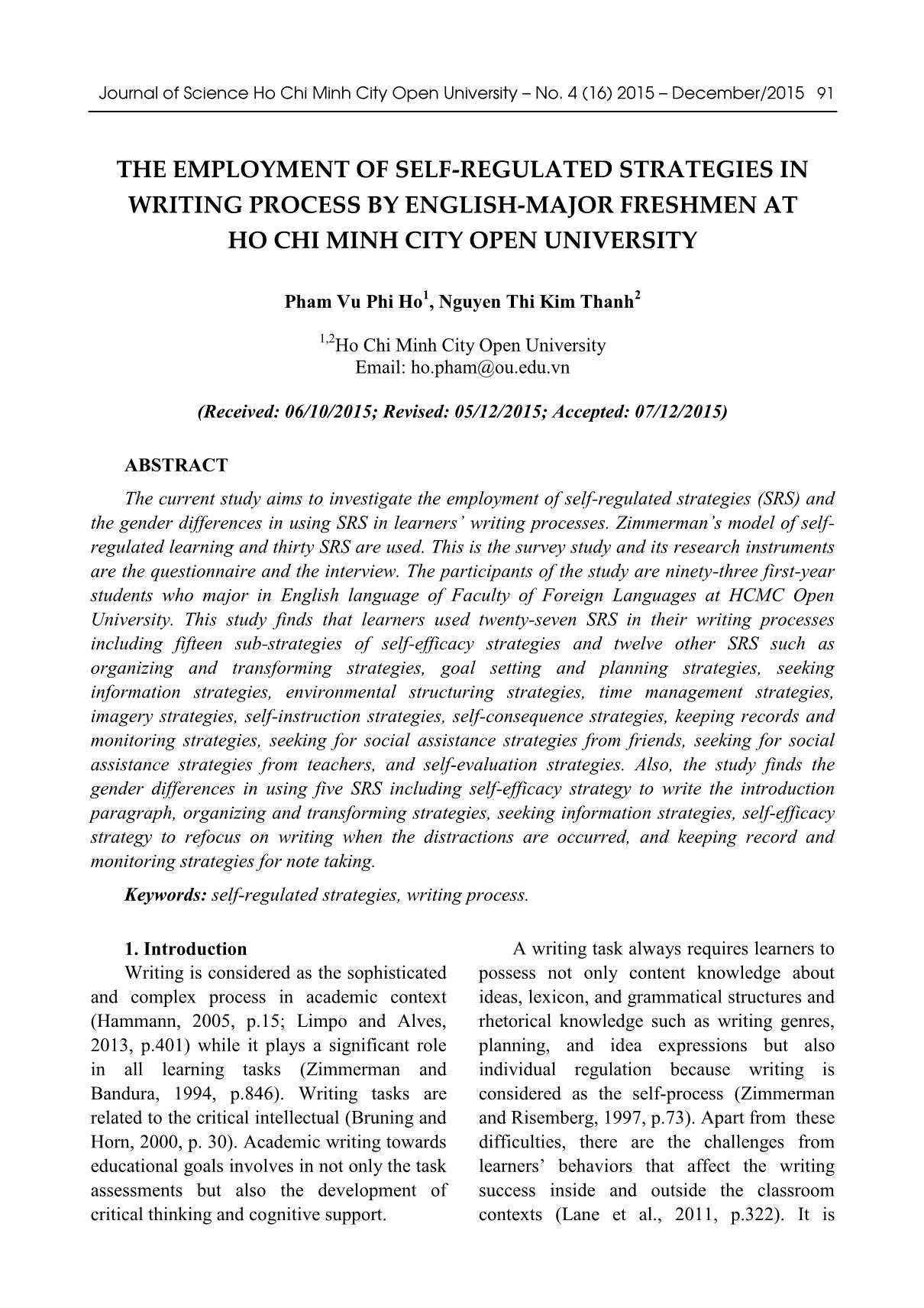
Trang 1
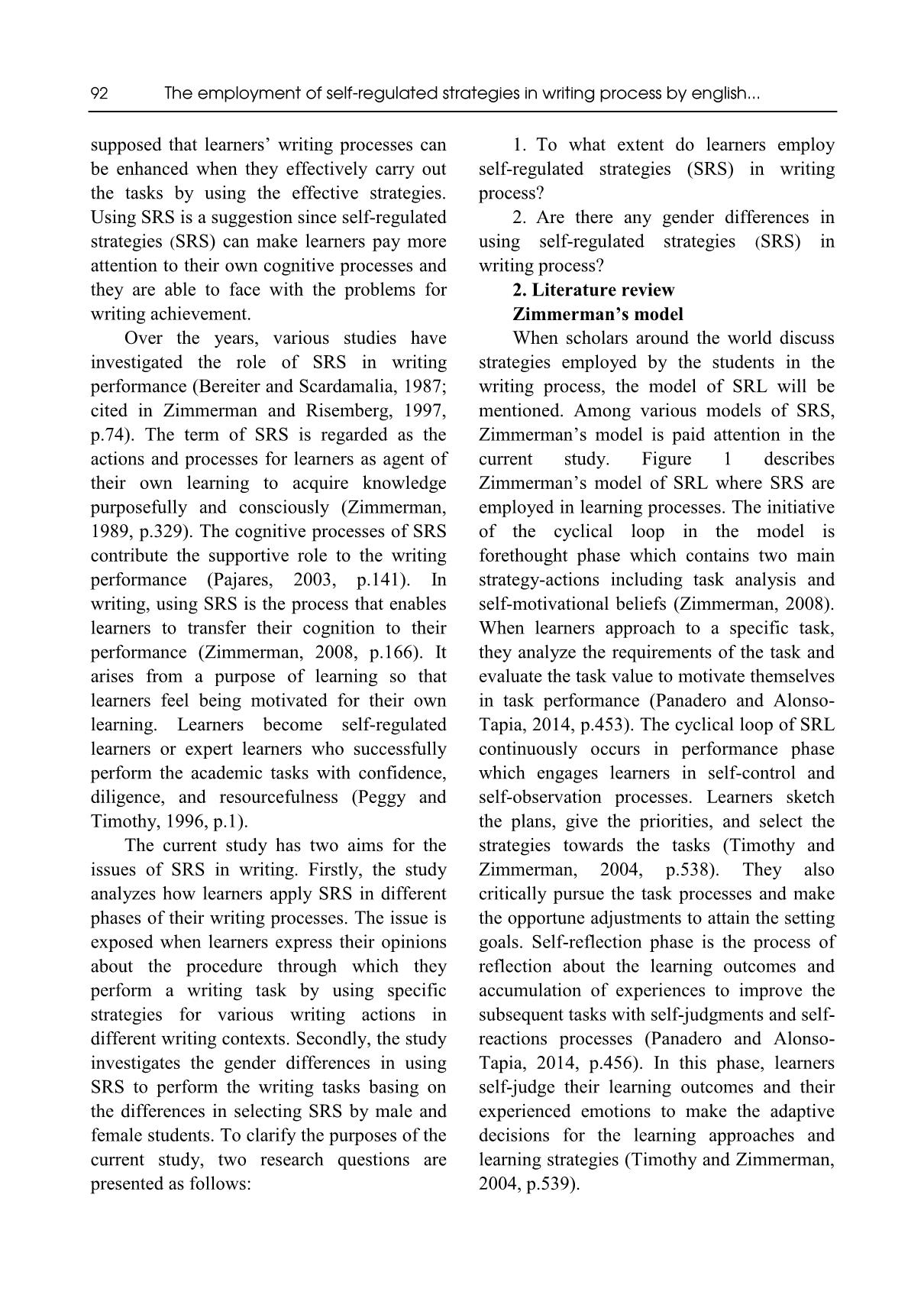
Trang 2
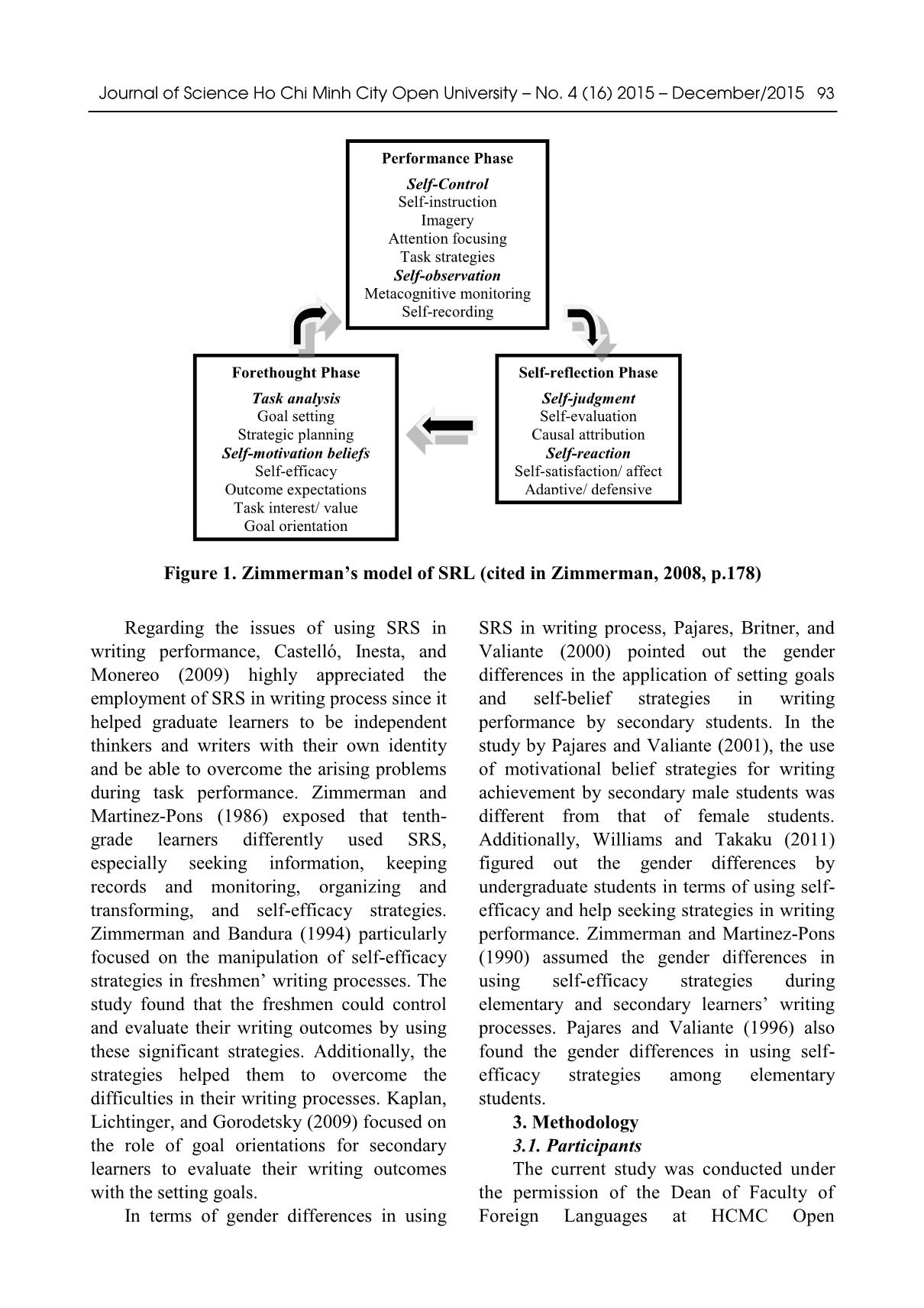
Trang 3
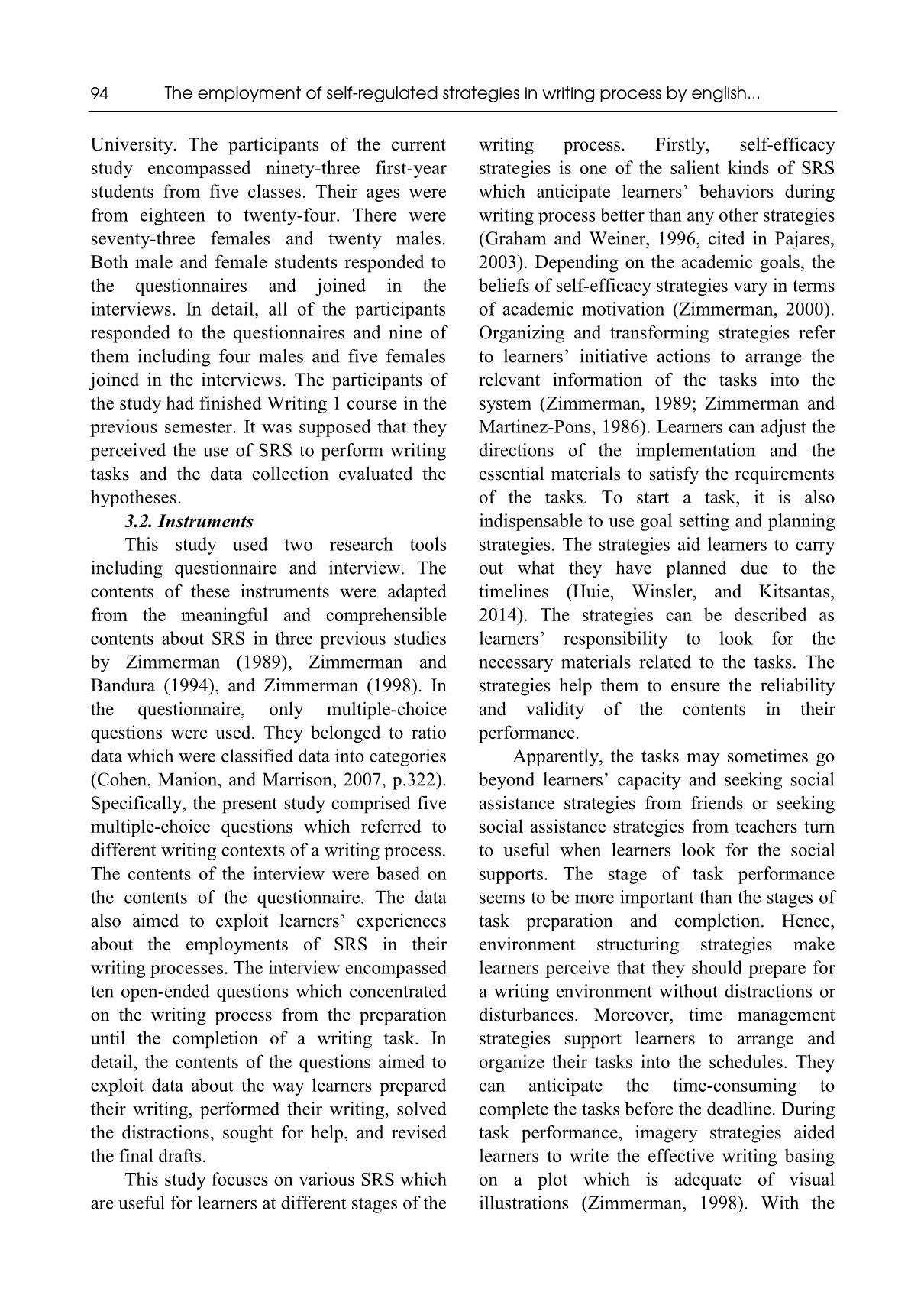
Trang 4
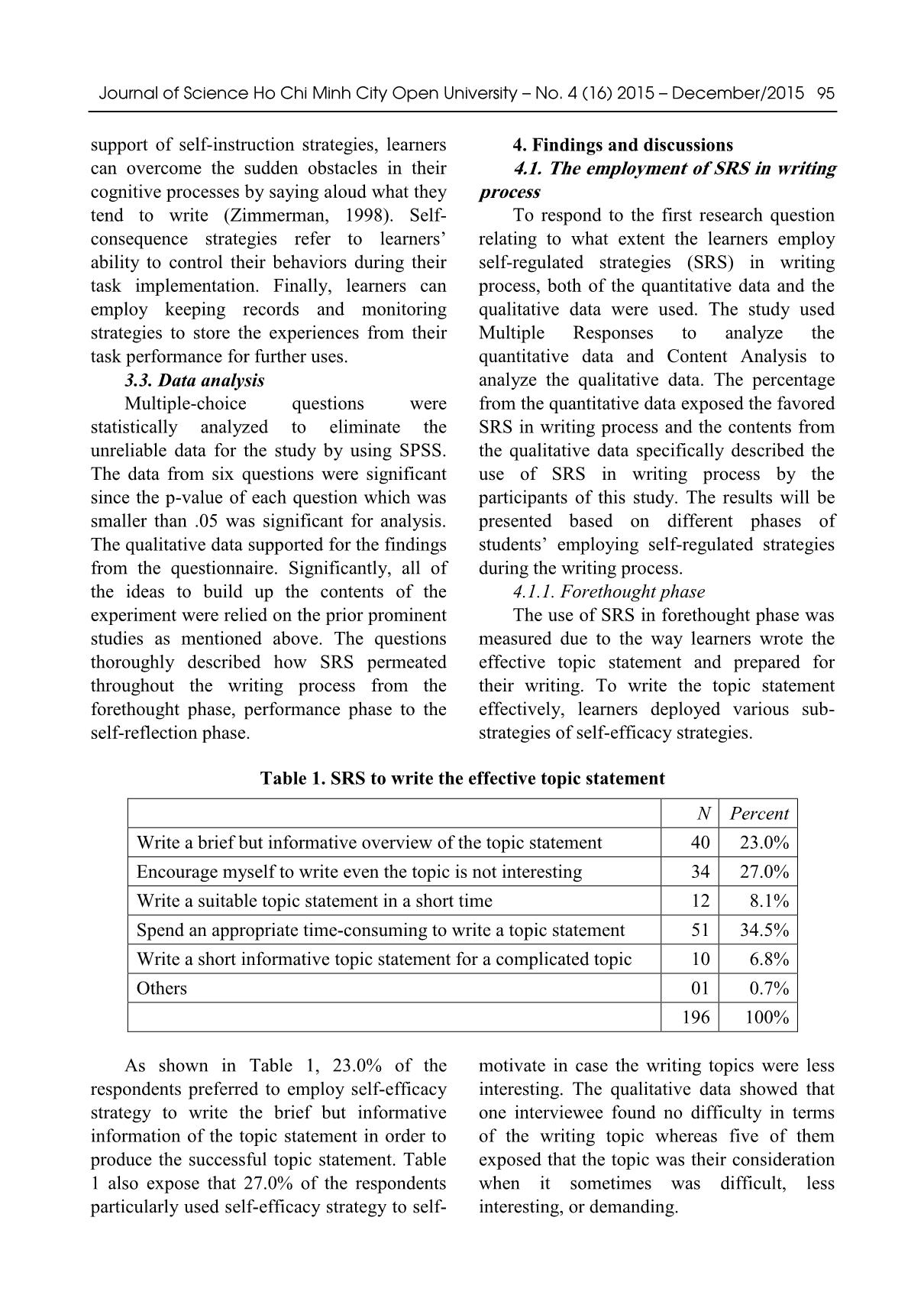
Trang 5
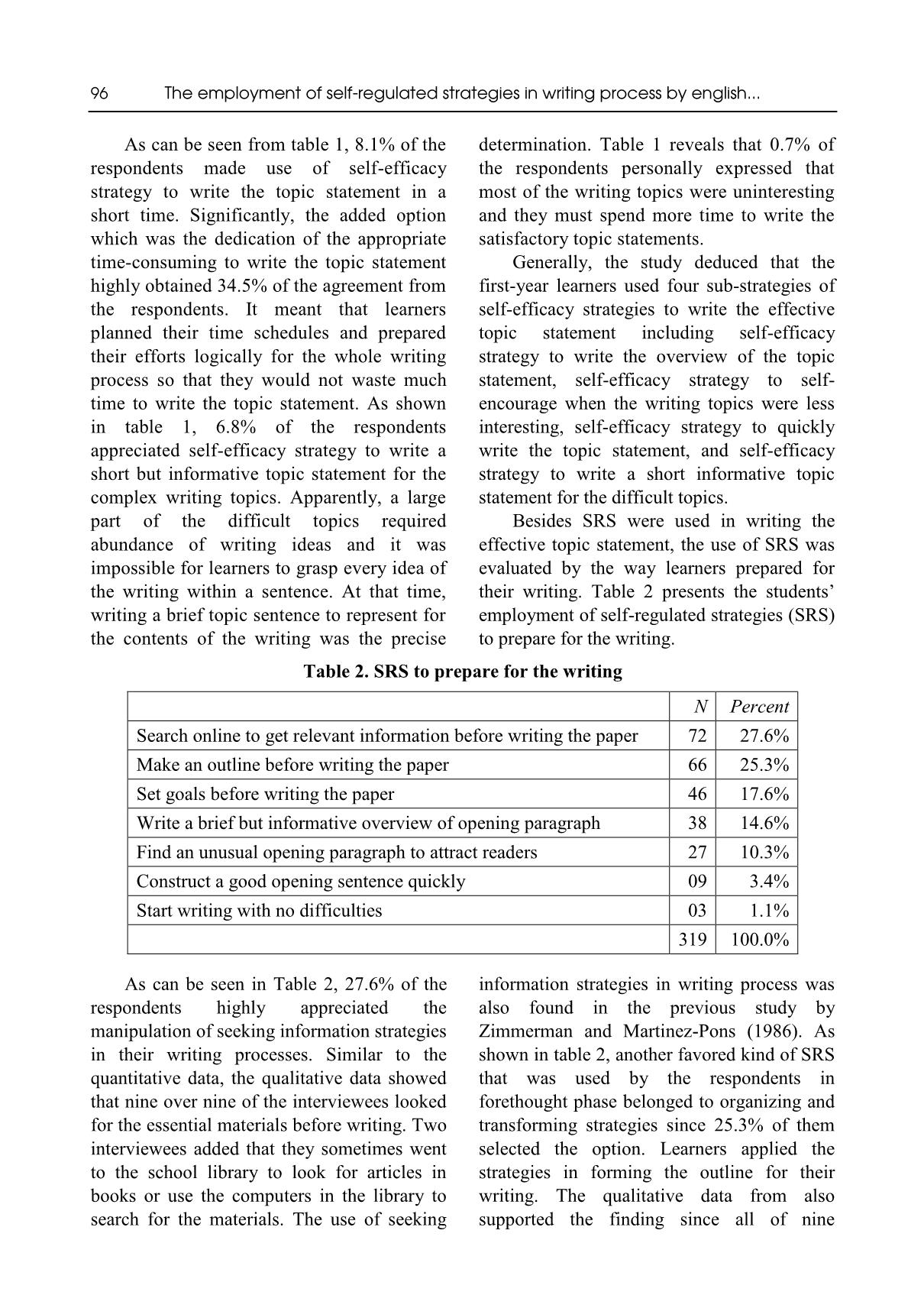
Trang 6
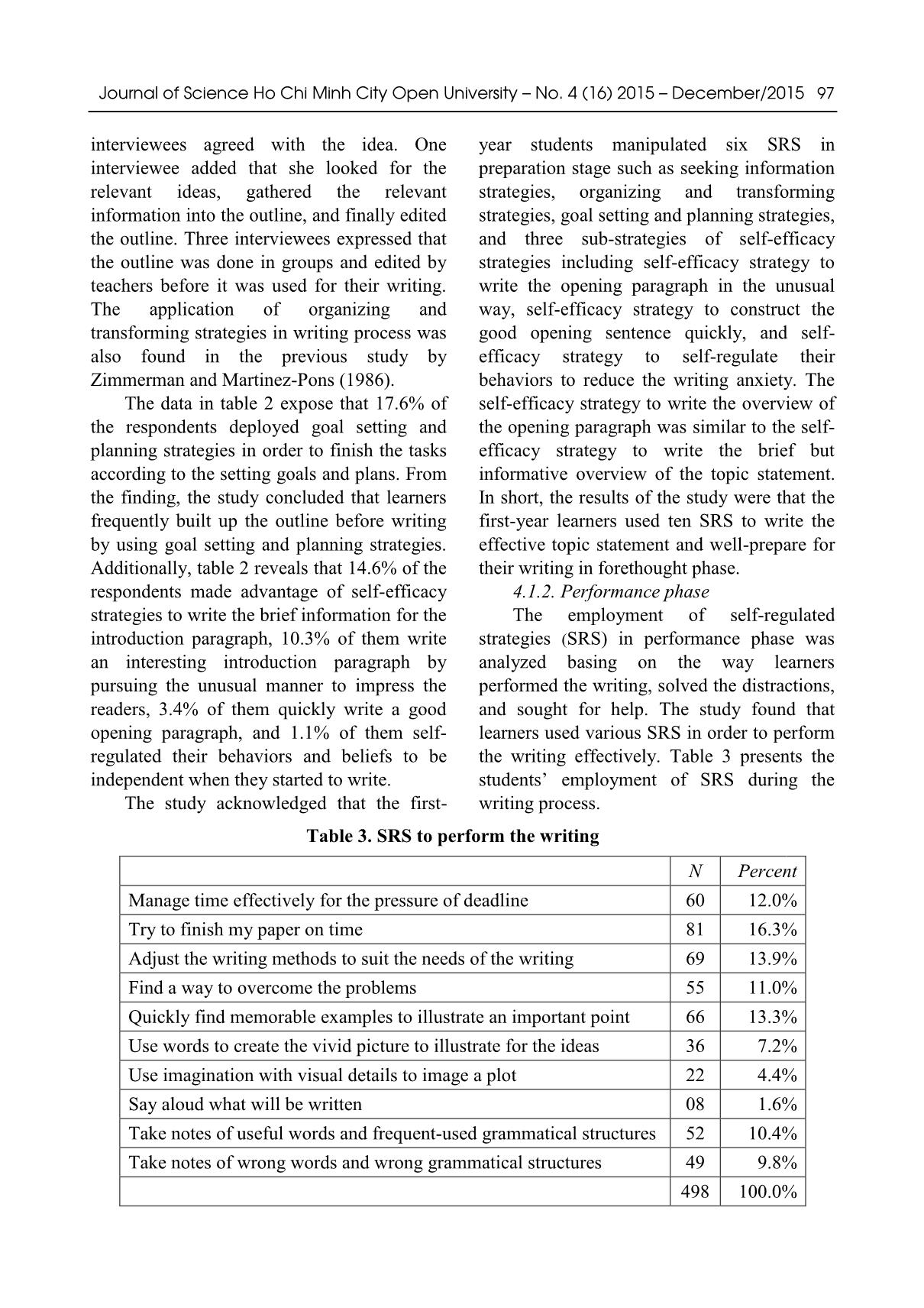
Trang 7
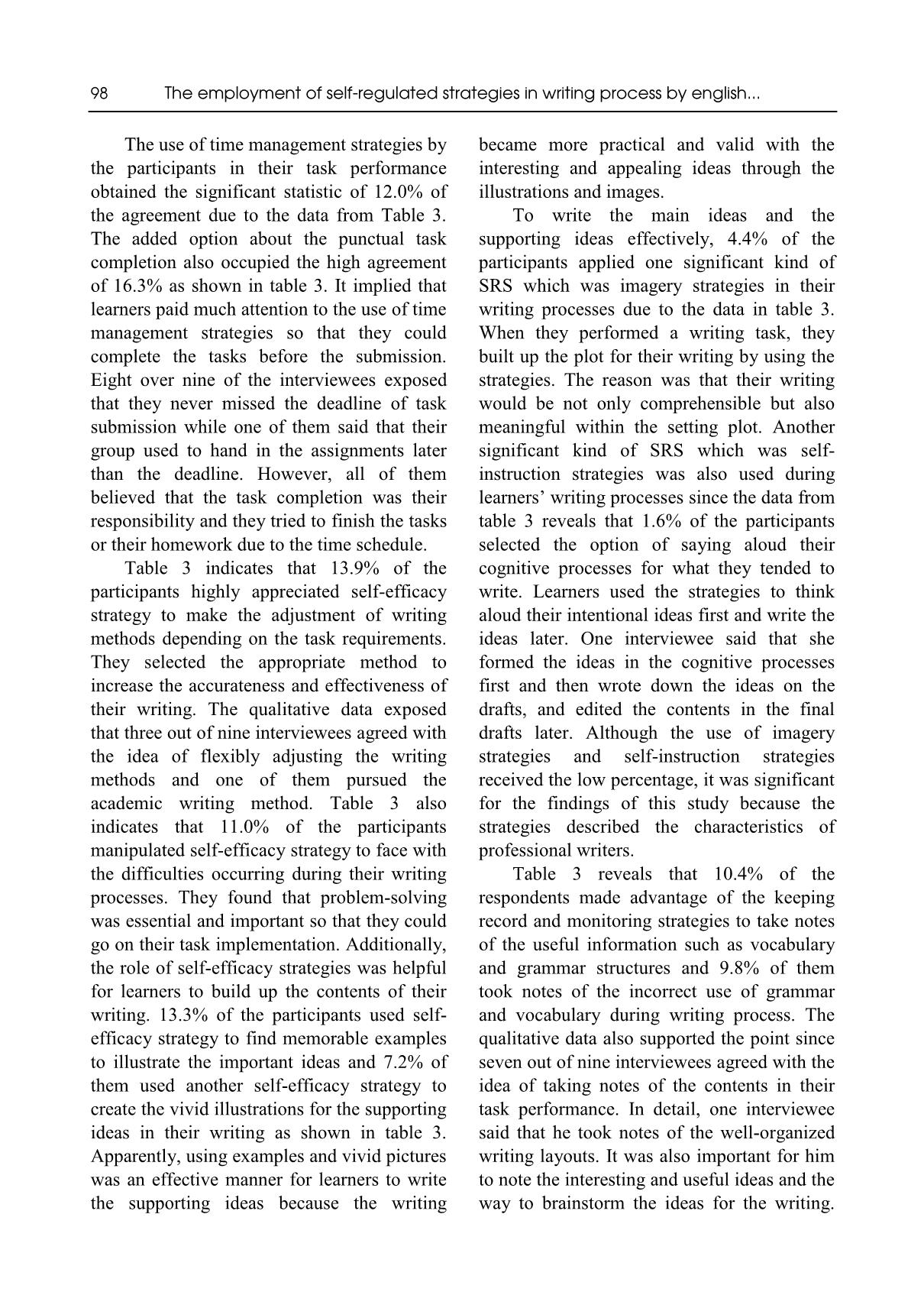
Trang 8
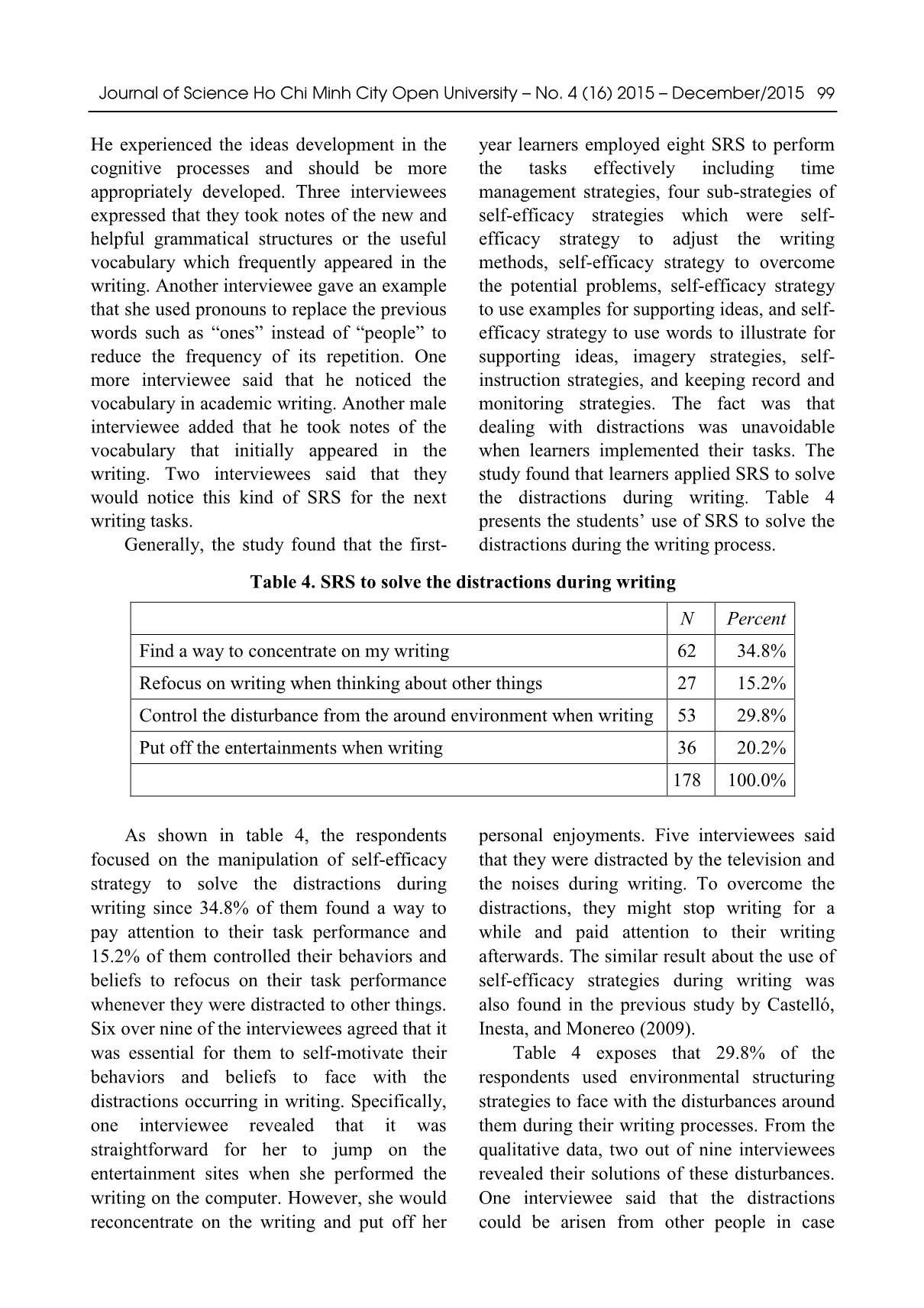
Trang 9
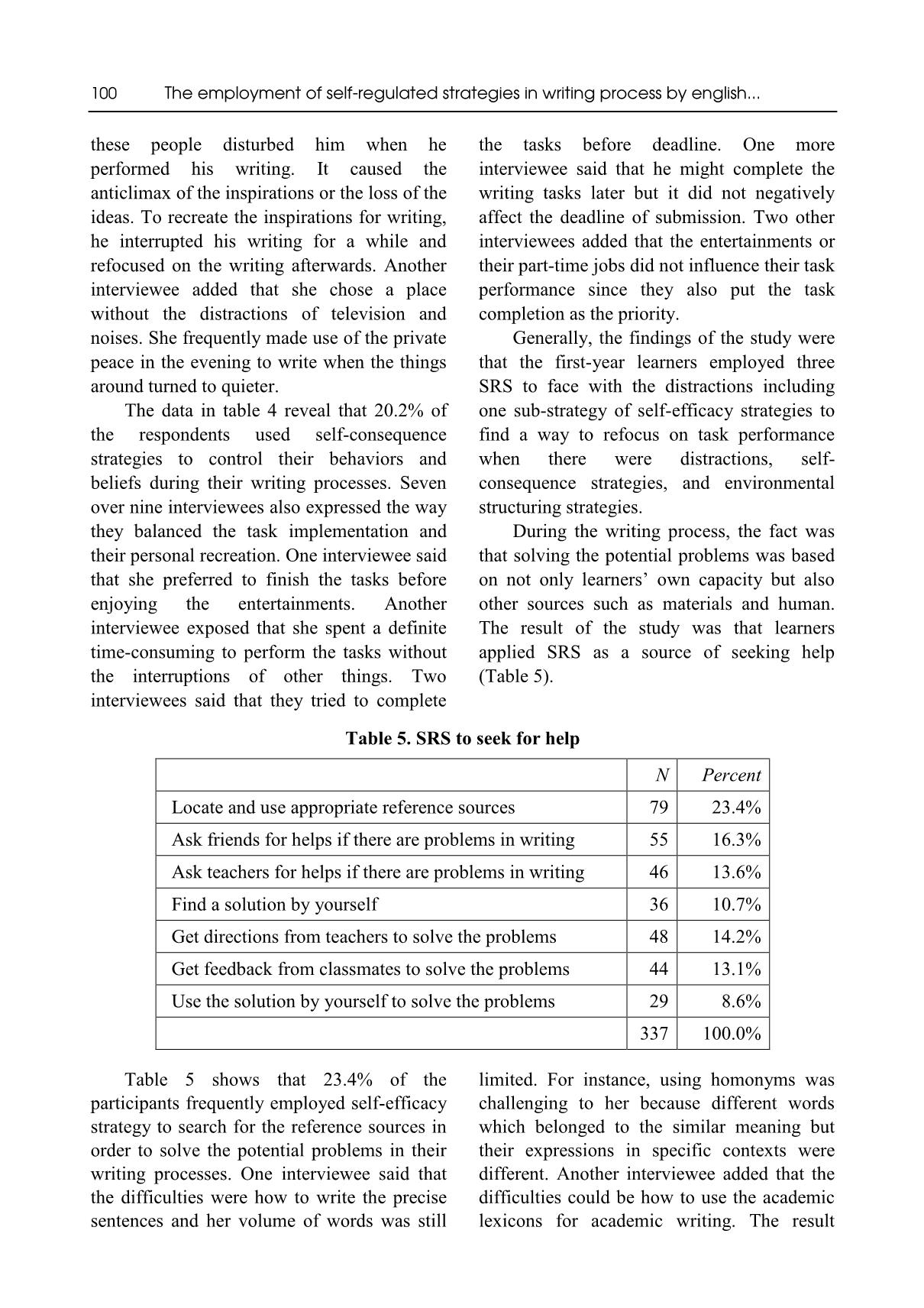
Trang 10
Tải về để xem bản đầy đủ
Tóm tắt nội dung tài liệu: The employment of self - Regulated strategies in writing process by English - major freshmen at ho chi minh city open university
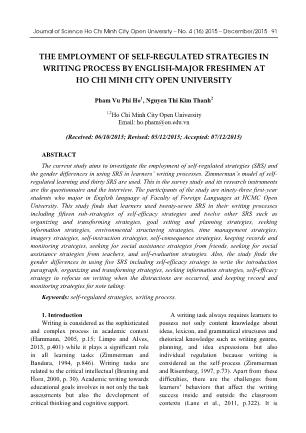
Journal of Science Ho Chi Minh City Open University – No. 4 (16) 2015 – December/2015 91 THE EMPLOYMENT OF SELF-REGULATED STRATEGIES IN WRITING PROCESS BY ENGLISH-MAJOR FRESHMEN AT HO CHI MINH CITY OPEN UNIVERSITY Pham Vu Phi Ho 1 , Nguyen Thi Kim Thanh 2 1,2 Ho Chi Minh City Open University Email: ho.pham@ou.edu.vn (Received: 06/10/2015; Revised: 05/12/2015; Accepted: 07/12/2015) ABSTRACT The current study aims to investigate the employment of self-regulated strategies (SRS) and the gender differences in using SRS in learners’ writing processes. Zimmerman’s model of self- regulated learning and thirty SRS are used. This is the survey study and its research instruments are the questionnaire and the interview. The participants of the study are ninety-three first-year students who major in English language of Faculty of Foreign Languages at HCMC Open University. This study finds that learners used twenty-seven SRS in their writing processes including fifteen sub-strategies of self-efficacy strategies and twelve other SRS such as organizing and transforming strategies, goal setting and planning strategies, seeking information strategies, environmental structuring strategies, time management strategies, imagery strategies, self-instruction strategies, self-consequence strategies, keeping records and monitoring strategies, seeking for social assistance strategies from friends, seeking for social assistance strategies from teachers, and self-evaluation strategies. Also, the study finds the gender differences in using five SRS including self-efficacy strategy to write the introduction paragraph, organizing and transforming strategies, seeking information strategies, self-efficacy strategy to refocus on writing when the distractions are occurred, and keeping record and monitoring strategies for note taking. Keywords: self-regulated strategies, writing process. 1. Introduction Writing is considered as the sophisticated and complex process in academic context (Hammann, 2005, p.15; Limpo and Alves, 2013, p.401) while it plays a significant role in all learning tasks (Zimmerman and Bandura, 1994, p.846). Writing tasks are related to the critical intellectual (Bruning and Horn, 2000, p. 30). Academic writing towards educational goals involves in not only the task assessments but also the development of critical thinking and cognitive support. A writing task always requires learners to possess not only content knowledge about ideas, lexicon, and grammatical structures and rhetorical knowledge such as writing genres, planning, and idea expressions but also individual regulation because writing is considered as the self-process (Zimmerman and Risemberg, 1997, p.73). Apart from these difficulties, there are the challenges from learners’ behaviors that affect the writing success inside and outside the classroom contexts (Lane et al., 2011, p.322). It is 92 The employment of self-regulated strategies in writing process by english... supposed that learners’ writing processes can be enhanced when they effectively carry out the tasks by using the effective strategies. Using SRS is a suggestion since self-regulated strategies (SRS) can make learners pay more attention to their own cognitive processes and they are able to face with the problems for writing achievement. Over the years, various studies have investigated the role of SRS in writing performance (Bereiter and Scardamalia, 1987; cited in Zimmerman and Risemberg, 1997, p.74). The term of SRS is regarded as the actions and processes for learners as agent of their own learning to acquire knowledge purposefully and consciously (Zimmerman, 1989, p.329). The cognitive processes of SRS contribute the supportive role to the writing performance (Pajares, 2003, p.141). In writing, using SRS is the process that enables learners to transfer their cognition to their performance (Zimmerman, 2008, p.166). It arises from a purpose of learning so that learners feel being motivated for their own learning. Learners become self-regulated learners or expert learners who successfully perform the academic tasks with confidence, diligence, and resourcefulness (Peggy and Timothy, 1996, p.1). The current study has two aims for the issues of SRS in writing. Firstly, the study analyzes how learners apply SRS in different phases of their writing processes. The issue is exposed when learners express their opinions about the procedure through which they perform a writing task by using specific strategies for various writing actions in different writing contexts. Secondly, the study investigates the gender differences in using SRS to perform the writing tasks basing on the differences in selecting SRS by male and female students. To clarify the purposes of the current study, two research questions are presented as follows: 1. To what extent do learners employ self-regulated strategies (SRS) in writing process? 2. Are there any gender differences in using self-regulated strategies (SRS) in writing process? 2. Literature review Zimmerman’s model When scholars around the world discuss strategies employed by the students in the writing process, the model of SRL will be mentioned. Among various models of SRS, Zimmerman’s model is paid attention in the current study. Figure 1 describes Zimmerman’s model of SRL where SRS are employed in learning processes. The initiative of the cyclical loop in the model is forethought phase which contains two main strategy-actions including task analysis and self-motivational beliefs (Zimmerman, 2008). When learners approach to a specific task, they analyze the requirements of the task and evaluate the task value to motivate themselves in task performance (Panadero and Alonso- Tapia, 2014, p.453). The cyclical loop of S ... g for relevant materials than the male students. Possibly, the sources of materials were various and the male and female students differently used the materials, which were reliable and valid, to build up the supporting ideas for their writing. The study acknowledged that the female first-year students were better in use of seeking information strategies than the male first-year students. As shown in table 7, the data for the gender difference in using organizing and transforming strategies reveal that the U score of this option (U=535.00), the Z score of this option (Z=-2.32), and the p-value of this option (p=.020) accepted the H1. On the other words, the study assumed that there was gender difference in using organizing and transforming strategies since the p-value of this option was moderately smaller than .05. Table 7 exposes that the MR (male students) = 37.25 while the MR (female students) = 49.67. It could be seen that the MR of the male students was moderately smaller than the MR of the female students. The statistics 104 The employment of self-regulated strategies in writing process by english... revealed that the female students frequently carried out the strategy-action of making outline before writing than the male students. Apparently, the outline is considered as the spine of their writing which organizes and connects all of the ideas in their writing into the system. However, the finding posed the supposition that some of the male learners might ignore the stage of forming the outline before writing. It made the study conclude that the use of organizing and transforming strategies was more significant towards the female first-year students than the male first- year students. The results of the present study were different from those in the prior studies. The prior studies gave out no differences for the use of self-efficacy strategy, organizing and transforming strategies, and seeking information strategies between the male and female students. Also, the present study found no gender difference in using goal setting and planning strategies but in the previous study by Pajares and Valiante (2001), the gender difference in goal orientation strategies was significant for the male students. With the similar objectives to figure out the gender differences in using SRS in learners’ writing processes, the prior study by Pajares, Britner, and Valiante (2000) found the gender difference in goal orientation strategies, particularly performance-approach, which was towards the female students. Zimmerman and Martinez-Pons (1990) also found the gender differences in using goal setting and planning strategies and the female students revealed the significant use of the strategies. Generally, the study assumed that the first-year male and female students differently used three kinds of SRS including self- efficacy strategy to quickly write the first opening sentence, organizing and transforming strategies, and seeking information strategies before writing. 4.2.2. Performance phase Table 8 presents the differences for the use of SRS in performance phase by the male and female participants. Table 8. Gender differences in using SRS in performance phase Gender N MR U Z p-value Take notes of useful words and frequent-used grammatical structures Male 20 37.28 535.50 -2.12 .034 Female 73 49.66 Refocus on writing when thinking about other things Male 20 38.15 553.00 -2.11 .035 Female 73 49.42 In performance phase, the study measured the gender difference in using keeping record and monitoring strategies. As can be seen from table 8, the U score of this option (U=535.50), the Z score of this option (Z=- 2.12), and the p-value of this option (p=.034) made the study accept the H1. As being shown, the gender difference in using keeping record and monitoring strategies was found in this study since the p-value of this option was slightly smaller than .05. Table 8 also shows that the MR (male students) = 37.28 while the MR (female students) = 49.66. As could be seen, the MR of the male students were significantly smaller than the MR of the female students. The data implied that the female students frequently took notes of the useful vocabulary and grammar structures than the male students. From the points, the study confirmed that the female first-year students could use keeping record and monitoring strategies better than the male Journal of Science Ho Chi Minh City Open University – No. 4 (16) 2015 – December/2015 105 first-year students. The similar finding about gender difference in using keeping record and monitoring strategies which was more significant for females was also found in the prior study by Zimmerman and Martinez-Pons (1990). The finding of this prior study (p=.010) was more significant than the current study (p=.034). Regarding the gender difference in using self-efficacy strategy to refocus on task performance, the data from Table 8 expose that the U score of this option (U=553.00), the Z score of this option (Z=-2.11), and the p- value of this option (p=.035) also accepted the H1. The data showed that the use of this kind of SRS by the male students was different from that by the female students since the p- value of this strategy was moderately smaller than .05. From the data of Table 8, the statistics showed that the MR (male students) = 38.15 whereas the MR (female students) = 49.42. As being shown, the MR of the male students was moderately smaller than the MR of the female students. The data exposed that the female students were able to reconcentrate on their task implementation faster than the male students. The fact was that the female students tended to stay away from the distractions and disturbances and they frequently prepared a quiet writing environment when they carried out their writing assignments. In case they were distracted from the task implementation, they were able to refocus on their writing immediately. The study deduced that the female first-year students were able to use self-efficacy strategy to refocus on writing when they were distracted to other things better than the male first-year students. In sum, the study concluded that the first- year male and female students differently used two kinds of SRS including keeping record and monitoring strategies for note taking of useful information and self-efficacy strategy to regulate their behaviors during writing. To respond to the second research question, the study concluded that the male and female first-year learners differently used five SRS in forethought phase and performance phase. None of the gender difference was found in self-reflection phase. 5. Implications and conclusion From the results of this study, it is implied that self-regulated strategies (SRS) are beneficial and satisfactory for successful learning, particularly in writing. Using the strategies can enhance learners’ learning proficiency and evoke the capacity of independent learning (Field, Duffy, and Huggins, 2014, p.2). Learners can alter SRS to systemize and organize their learning in an effective way so that they have a feeling of being motivated, consider learning as their own responsibility, and feel comfortable to cooperate with others for their own sake in learning (Zimmerman, 1986, p.308; cited in Field, Duffy, and Huggins, 2014, p.2). They become autonomous in their own learning when they control their learning with a proper schedule, arrange time for learning scientifically, and understand their learning competence towards the tasks deliberately. They are provided with opportunities to accumulate learning experiences through motivation and curiosity, self-confidence, and self-reliance basing on their comprehension and ability. The knowledge in human’ mind can be forgotten and the perception of SRS is not the exception. Hence, this study is a reminder about the manipulation of SRS which principally aims to evoke its contents in learners’ minds so that they can continue to make use of the usefulness of the strategies in their own learning, particularly in writing performance. Additionally, the unfamiliar SRS are approached to them so that they can exploit the use of these strategies in the further tasks. 106 The employment of self-regulated strategies in writing process by english... REFERENCES Castelló, M., Inesta, A., &Monereo, C. (2009). Toward self-regulated academic writing: An exploratory study with graduate students in a situated learning environment. Electronic Journal of Research in Educational Psychology, 7 (3). 1107-1130. Cohen, L., Manion, L., & Morrison, K. (2007). Research method in education. New York, NY: Routledge. Field, R. M., Duffy, J., & Huggins, A. (2014). Independent learning skills, self-determination theory and psychological well-being: Strategies for supporting the first year university experience. International First Year in Higher Education Conference.1-10. Darwin Convention and Exhibition Centre, Darwin, NT. Hammann, L. (2005). Self-regulation in academic writing tasks. International Journal of Teaching and Learning in Higher Education, 17 (1). 15-26. Huie, C. F., Winsler, A., &Kitsantas, A. (2014). Employment and first-year college achievement: The role of self-regulation and motivation. Journal of Education and Work, 27 (1). 110-135. Routledge. Kaplan, A., Lichtinger, E., &Gorodetsky, M. (2009). Achievement goal orientations and self- regulation in writing: An integrative perspective. Journal of Educational Psychology, 101 (1). 51-69. American Psychological Association. Lane, L. K., et al. (2011). Self-regulated strategy development at tier 2 for second-grade students with writing and behavioral difficulties: A randomized controlled trial. Journal of Research on Educational Effectiveness 4. 322-353. Routledge. Limpo, T., & Alves, A. R. (2013). Modeling writing development: Contribution of transcription and self-regulation to Portuguese students’ text generation quality. Journal of Educational Psychology 105 (2). 401-413. American Psychological Association, Inc. Pajares, F. (2003). Self-efficacy beliefs, motivation, and achievement in writing: A review of the literature. Reading & Writing Quarterly, 19. 139-158. Taylor & Francis Group. Pajares, F., and Valiante, G. (1986). Predictive utility and causal influence of the writing self- efficacy beliefs of elementary students. Paper presented at the Annual Meeting of the American Educational Research Association. Eric. Pajares, F., and Valiante, G. (2001). Gender differences in writing motivation and achievement of middle school students: A function of gender orientation? Contemporary Educational Psychology, 26. 366-381. Elsevier. Pajares, F., Britner, L. S., and Valiante, G. (2000). Relation between achievement goals and self- beliefs of middle school students in writing and science. Contemporary Educational Psychology, 25.4 06-422. Elsevier. Journal of Science Ho Chi Minh City Open University – No. 4 (16) 2015 – December/2015 107 Panadero, E., & Alonso-Tapia, J. (2014). How do students self-regulate? Review of Zimmerman’s cyclical model of self-regulated learning. Anales de Psicología, 40 (2). Servicio de Publicaciones de la Universidad de Murcia. Peggy, A. E., & Timothy, J. N. (1996). The expert learner: Strategic, self-regulated, and reflective. Instructional Science, 24. 1-24. Springer. Timothy, J. C., & Zimmerman, J. B. (2004). Self-regulation empowerment program: A school- based program to enhance self-regulated and self-motivated cycles of student learning. Psychology in the Schools, 41 (5). 357-550. Wiley Periodicals, Inc. Zimmerman, J. B. (1989). A social cognitive view of self-regulated academic learning. Journal of Educational Psychology, 81 (3). 329-339. American Psychological Association, Inc. Zimmerman, J. B. (1990). Self-regulated learning and academic achievement: An overview. Educational Psychologist, 25 (1). 3-17. Lawrence Erlbaum Associated, Inc. Zimmerman, J. B. (1998). Academic studying and the development of personal skill: A self- regulatory perspective. Educational Psychologist, 33 (2/3). 73-86. Lawrence Erlbaum Associated, Inc. Zimmerman, J. B. (2000). Self-efficacy: An essential motive to learn. Contemporary Educational Psychology, 25. 82-91. Elsevier Inc. Zimmerman, J. B. (2008). Investigating self-regulation and motivation: Historical background, methodological developments, and future prospects. American Educational Research Journal, 45 (1). 166-183. Sage Publication. Zimmerman, J. B., & Bandura, A. (1994). Impact of self-regulatory influences on writing course attainment. American Educational Research Journal, 31 (4). 845-862. Sage Journals. Zimmerman, J. B., & Martinez-Pons, M. (1986). Development of a structured interview for assessing student use of self-regulated learning strategies. American Education Research Journal, 23 (4). 614-628. Sage Journals. Zimmerman, J. B., & Martinez-Pons, M. (1990). Student differences in self-regulated learning: Relating grade, sex, and giftedness to self-efficacy and strategy use. Journal of Educational Psychology, 82 (1). 51-59. American Psychological Association, Inc. Zimmerman, J. B., &Risemberg, R. (1997). Becoming a self-regulated writer: A social cognitive perspective. Contemporary Educational Psychology, 22. 73-101. Elsevier Inc. Wiliams, D. J., and Takaku, Seiji. (2011). Gender, writing self-efficacy, and help seeking. International Journal of Business, Humanities and Technology, 1 (3). 46-54. ResearchGate.
File đính kèm:
 the_employment_of_self_regulated_strategies_in_writing_proce.pdf
the_employment_of_self_regulated_strategies_in_writing_proce.pdf

